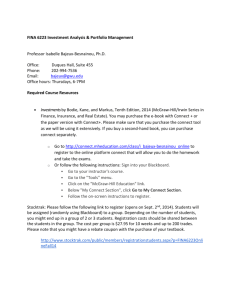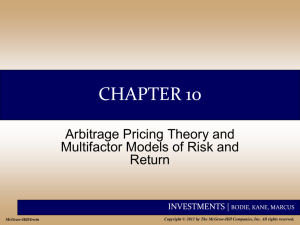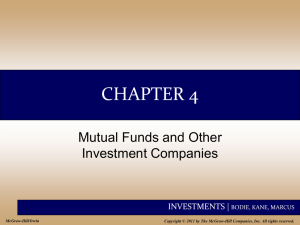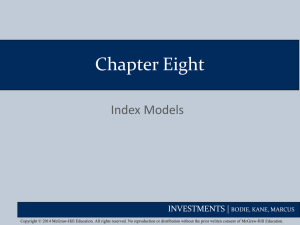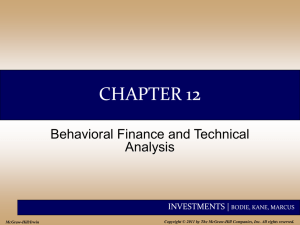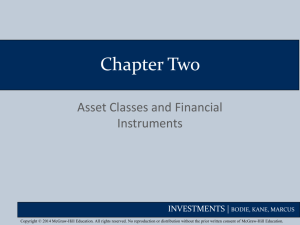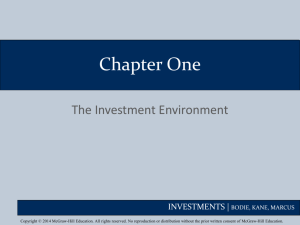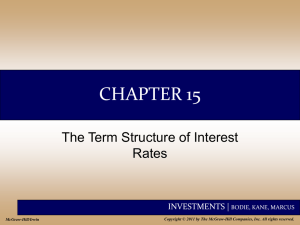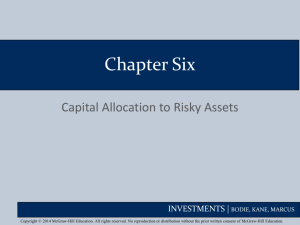Ch009
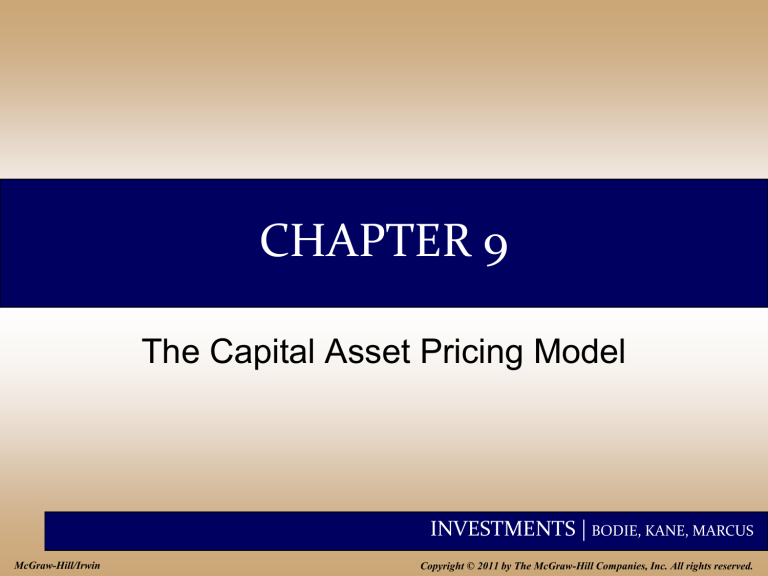
McGraw-Hill/Irwin
CHAPTER 9
The Capital Asset Pricing Model
INVESTMENTS |
BODIE, KANE, MARCUS
Copyright © 2011 by The McGraw-Hill Companies, Inc. All rights reserved.
Capital Asset Pricing Model (CAPM)
• It is the equilibrium model that underlies all modern financial theory
• Derived using principles of diversification with simplified assumptions
• Markowitz, Sharpe, Lintner and Mossin are researchers credited with its development
9-2
INVESTMENTS |
BODIE, KANE, MARCUS
Assumptions
• Individual investors are price takers
• Single-period investment horizon
• Investments are limited to traded financial assets
• No taxes and transaction costs
• Information is costless and available to all investors
• Investors are rational mean-variance optimizers
• There are homogeneous expectations
INVESTMENTS |
BODIE, KANE, MARCUS
9-3
Resulting Equilibrium Conditions
• All investors will hold the same portfolio for risky assets – market portfolio
• Market portfolio contains all securities and the proportion of each security is its market value as a percentage of total market value
9-4
INVESTMENTS |
BODIE, KANE, MARCUS
Resulting Equilibrium Conditions
• Risk premium on the market depends on the average risk aversion of all market participants
• Risk premium on an individual security is a function of its covariance with the market
9-5
INVESTMENTS |
BODIE, KANE, MARCUS
Figure 9.1 The Efficient Frontier and the
Capital Market Line
9-6
INVESTMENTS |
BODIE, KANE, MARCUS
Market Risk Premium
•The risk premium on the market portfolio will be proportional to its risk and the degree of risk aversion of the investor:
( )
M
f
A
M
2 where
2
M
is the variance of the market portolio and
A is the average degree of risk aversion across investors
9-7
INVESTMENTS |
BODIE, KANE, MARCUS
Return and Risk For Individual
Securities
• The risk premium on individual securities is a function of the individual security’s contribution to the risk of the market portfolio.
• An individual security’s risk premium is a function of the covariance of returns with the assets that make up the market portfolio.
9-8
INVESTMENTS |
BODIE, KANE, MARCUS
GE Example
• Covariance of GE return with the market portfolio:
( , r
GE M
)
Cov r
GE
, k n
1 w r k k
k n
1 w Cov r r k
( , k GE
)
• Therefore, the reward-to-risk ratio for investments in GE would be:
GE's contribution to risk premium
GE's contribution to variance w
GE
(
GE
)
r f w Cov r
GE
( , r
GE M
)
(
GE
)
r f
Cov r , r
GE M
)
9-9
INVESTMENTS |
BODIE, KANE, MARCUS
9-10
GE Example
• Reward-to-risk ratio for investment in market portfolio:
Market risk premium
Market variance
(
M
)
r f
2
M
• Reward-to-risk ratios of GE and the market portfolio should be equal:
E
Cov r
GE
r
GE
, r r
M f
E
M
2
M r f
INVESTMENTS |
BODIE, KANE, MARCUS
GE Example
• The risk premium for GE:
E
GE
r f
COV
r
GE
2
M
, r
M
M
r f
• Restating, we obtain:
E
GE
r f
GE
E
M
r f
INVESTMENTS |
BODIE, KANE, MARCUS
9-11
Expected Return-Beta Relationship
• CAPM holds for the overall portfolio because:
E r
P
P
k
k w E r k
( ) and k w
k k
• This also holds for the market portfolio:
(
M
)
f
M
(
M
)
r f
9-12
INVESTMENTS |
BODIE, KANE, MARCUS
Figure 9.2 The Security Market Line
9-13
INVESTMENTS |
BODIE, KANE, MARCUS
Figure 9.3 The SML and a Positive-Alpha
Stock
9-14
INVESTMENTS |
BODIE, KANE, MARCUS
The Index Model and Realized
Returns
• To move from expected to realized returns, use the index model in excess return form:
R i
i
R i M
e i
• The index model beta coefficient is the same as the beta of the CAPM expected return-beta relationship.
9-15
INVESTMENTS |
BODIE, KANE, MARCUS
Figure 9.4 Estimates of Individual
Mutual Fund Alphas, 1972-1991
9-16
INVESTMENTS |
BODIE, KANE, MARCUS
9-17
Is the CAPM Practical?
• CAPM is the best model to explain returns on risky assets. This means:
– Without security analysis, α is assumed to be zero.
– Positive and negative alphas are revealed only by superior security analysis.
INVESTMENTS |
BODIE, KANE, MARCUS
Is the CAPM Practical?
• We must use a proxy for the market portfolio.
• CAPM is still considered the best available description of security pricing and is widely accepted.
9-18
INVESTMENTS |
BODIE, KANE, MARCUS
Econometrics and the Expected Return-
Beta Relationship
• Statistical bias is easily introduced.
• Miller and Scholes paper demonstrated how econometric problems could lead one to reject the
CAPM even if it were perfectly valid.
9-19
INVESTMENTS |
BODIE, KANE, MARCUS
Extensions of the CAPM
• Zero-Beta Model
– Helps to explain positive alphas on low beta stocks and negative alphas on high beta stocks
• Consideration of labor income and non-traded assets
9-20
INVESTMENTS |
BODIE, KANE, MARCUS
9-21
Extensions of the CAPM
• Merton’s Multiperiod
Model and hedge portfolios
• Incorporation of the effects of changes in the real rate of interest and inflation
• Consumption-based
CAPM
• Rubinstein, Lucas, and Breeden
• Investors allocate wealth between consumption today and investment for the future
INVESTMENTS |
BODIE, KANE, MARCUS
Liquidity and the CAPM
• Liquidity: The ease and speed with which an asset can be sold at fair market value
• Illiquidity Premium: Discount from fair market value the seller must accept to obtain a quick sale.
– Measured partly by bid-asked spread
– As trading costs are higher, the illiquidity discount will be greater.
9-22
INVESTMENTS |
BODIE, KANE, MARCUS
Figure 9.5 The Relationship Between
Illiquidity and Average Returns
9-23
INVESTMENTS |
BODIE, KANE, MARCUS
Liquidity Risk
• In a financial crisis, liquidity can unexpectedly dry up.
• When liquidity in one stock decreases, it tends to decrease in other stocks at the same time.
• Investors demand compensation for liquidity risk
– Liquidity betas
9-24
INVESTMENTS |
BODIE, KANE, MARCUS
